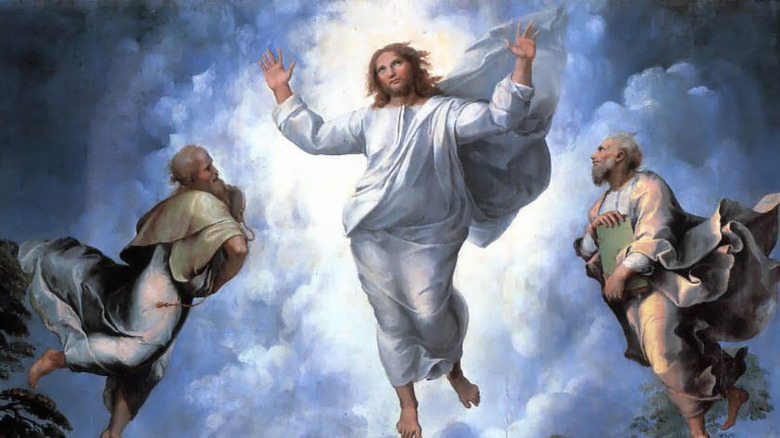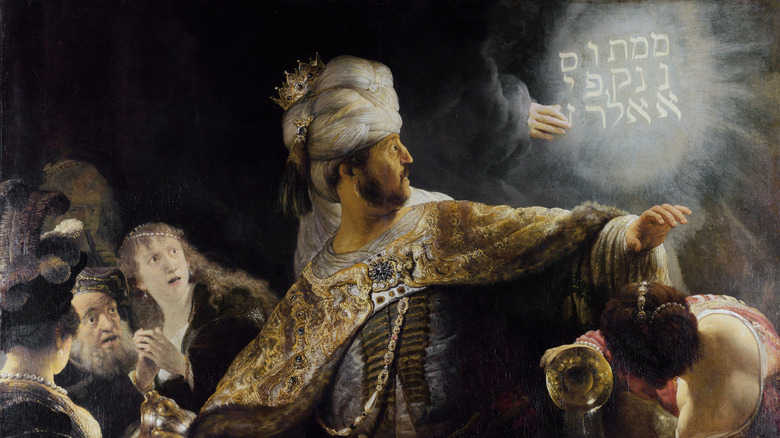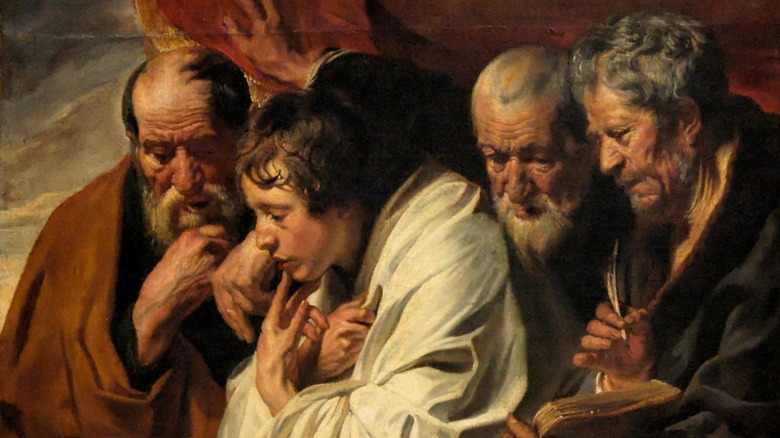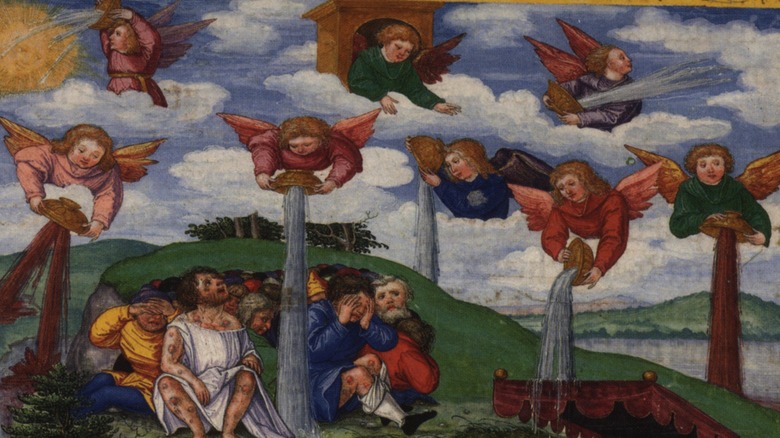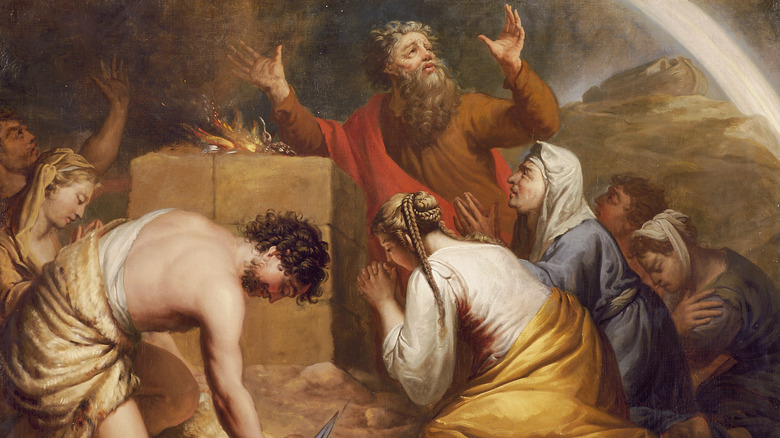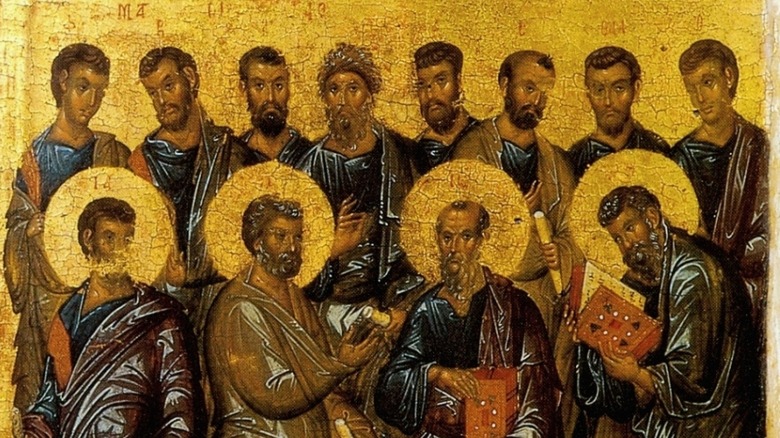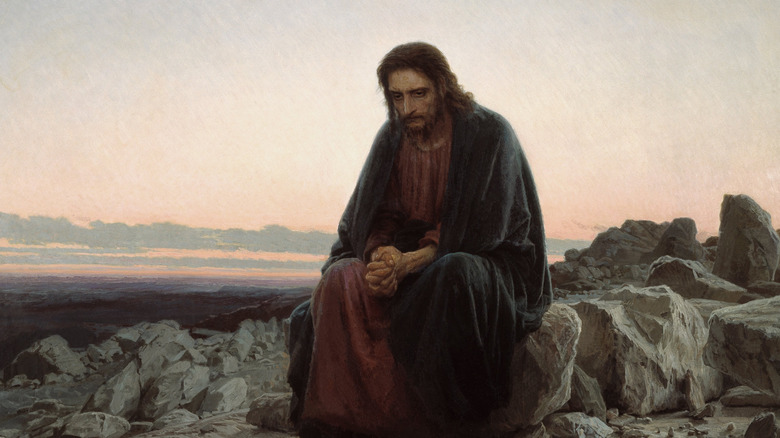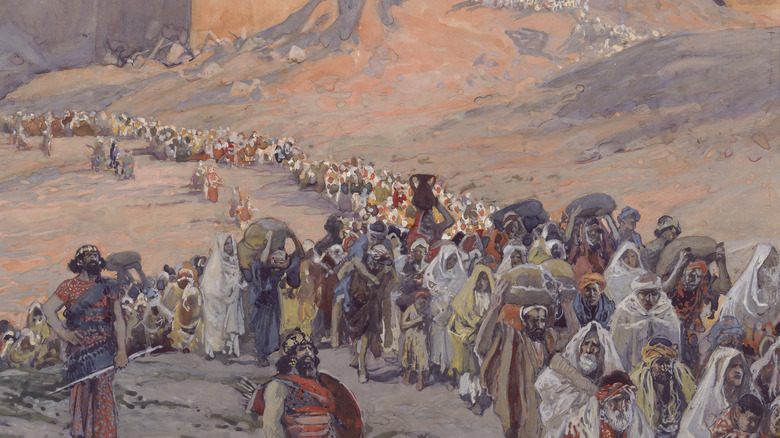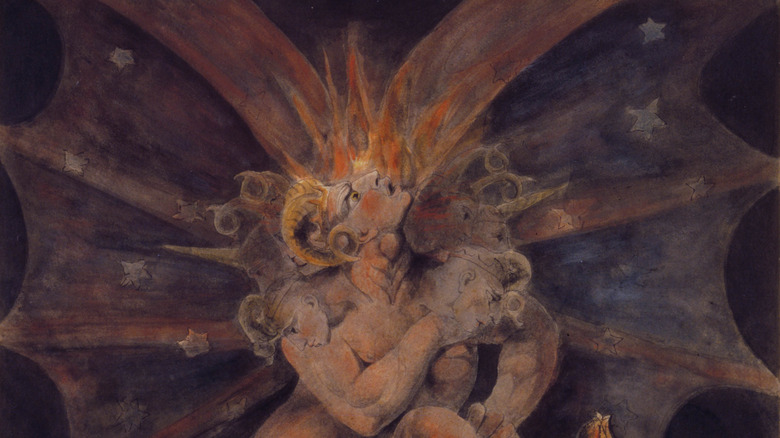What These Numbers In The Bible Really Mean
While the Bible is probably best known for its use of words — like "God is my shepherd, I shall not want" or "For God so loved the world" — the Bible is also a book full of numbers. Heck, there's even a whole book in there actually called Numbers. In fact, if you were to sit down and read even just a few of the more famous books of the Bible, it wouldn't take long before you started to notice the repetition of a few key numbers, like 7, 12, or 40. You might start to suspect there was something to these numbers apart from their literal value.
And you would be right! Many different numbers have significant symbolic weight throughout scripture, making the passages in which they appear more poetically resonant as things occur in groups that present echoes of perfection, or judgment, or unity. Here is just a small handful of the many symbolic numbers in the Bible and what they can mean.
2: The Number of Witness
The number 2 is of course a very commonly occurring number in day-to-day situations, so it's not a huge surprise that it has a few different symbolic contexts in the Bible. Ironically, it can mean both unity — as of man and woman in the creation of Adam and Eve, or as of Jesus and his symbolic bride, the Church — and division — as in the divided kingdoms of Israel and Judah, or the distinction between the Old and New Covenants as conceived of by Christians.
However, most often, the number 2 is used in the context of the number of witnesses needed to verify a statement as true. This law is made explicit in 1 Timothy, which says, "Do not entertain an accusation against an elder unless it is brought by two or three witnesses." To this end, we can see a number of places throughout the Bible where two witnesses appear, such as Joshua and Caleb, the two truthful spies sent into the Holy Land, the two cherubim who bear witness to the presence of God on the mercy seat of the Ark of the Covenant, and the two witnesses who accused Jesus before the Sanhedrin.
Perhaps the most interesting example, though, are the Two Witnesses from Revelation who will be killed for their efforts in opposing the False Prophet. These men are traditionally understood to be Enoch and Elijah, two guys from the Hebrew Bible who never died.
3: A Number of Strength
As anyone with a little bit of knowledge of geometry can tell you, three is a solid and stable number. While the popular claim that triangles are the strongest shape might be debatable, triangles are definitely valued in engineering for their strength, and of course, three legs on a stool are significantly more stable than two. As a result, the number 3 appears many times throughout the Bible as a symbol of completeness, stability, and strength. Within Judaism, there are three Patriarchs — Abraham, Isaac, and Jacob — and three pilgrimage festivals — Passover, Shavuot, and Sukkot. Prophets such as Elijah and Daniel are shown to call upon God or pray three times for additional efficacy in their requests.
The number 3 is arguably even more significant in Christianity, as the crucified Jesus remained in the grave for three days, a symbolic echo of the time the prophet Jonah spent three days in the belly of a big fish. Additionally, the doctrine of the Trinity is central to orthodox Christianity, which teaches that God exists as three Persons: the Father, the Son, and the Holy Spirit. Three disciples — Peter, James, and John — bore witness to Jesus' transfiguration into a divinely glorious figure on a mountaintop, where he was joined by Moses and Elijah (which adds up to ... well, you get it). As the song says, "Three is a magic number."
3.5: Incompletion
You probably weren't expecting to have to deal with fractions or decimals when talking about significant biblical numbers, but the fact is that 3.5 is a surprisingly common symbol in biblical numerology. This maybe makes more sense when you realize that 3.5 is half of 7, which — as we'll see coming up — is the number of completion. As a result, 3.5 is a natural symbol for incompletion: a broken 7. The most prominent example of this number being used in the Bible is during the apocalyptic vision of the prophet Daniel in Daniel chapter 12, in which an angel foretells that there will come "a time, times, and half a time" — that is, a year, two years, and half a year, or 3.5 years — during which the faithful Israelites will suffer persecution under a beast that many understand to represent Antiochus Epiphanes, the Greek ruler who desecrated the temple in the second century BCE.
The Book of Revelation, which makes heavy use of imagery from the apocalyptic section of Daniel, also uses the span of 3.5 years throughout its various visions. The author of Revelation offers some variation on the basic 3.5 symbolism by also utilizing the numbers 42 — that is, the number of months in 3.5 years — and 1,260 — the number of days in the same period — as, for example, the amount of time the Two Witnesses will prophesy.
4: The Number of the Earth
The number 4 is used in biblical contexts to represent the Earth and the natural world. This symbolic connection should still be a fairly resonant one even for modern audiences, because whether we do so consciously or not, we still associate the natural world with things grouped in bunches of four: the four seasons, the four cardinal directions, the four classical elements, and so on. The Bible similarly makes these associations, so that 4 can in a sense represent totality, in the way that "the four corners of the Earth" means everything everywhere. This exact phrase is used, for example, in Isaiah 11:12.
In the famous prophetic vision of Ezekiel, in which the prophet sees the chariot-throne of God, the throne is being guided by four "living creatures" (elsewhere identified as cherubim) made up of four types of animals — lion, bull, eagle, and man, representing the four "kings" of the animal kingdom; wild, domestic, sky, and everything — who can see and move in the four cardinal directions without turning. These four creatures later show up in Revelation and even later become symbols for the four Gospel writers. In the body of literature about God's throne, four archangels, again representing the four corners of Earth, surround God's fanciest chair. Another famous quartet representing the whole world is the four rivers that flow out of the Garden of Eden in Genesis.
7: The Number of Perfection
Probably the most significant symbolic number in all of the Bible is the number 7, which represents completion and perfection. If you start reading the Bible from the beginning, literally the first thing you will read about is the seven days of creation, including the seventh day on which God rested, setting up the elevated status of the Sabbath in Judaism. Expanding out from there, 7 reappears in Judaism as the number of Laws of Noah, the number of Patriarchs and Matriarchs (Abraham, Isaac, Jacob, Sarah, Rebecca, Rachel, and Leah), the number of branches on the Temple menorah, and the length of several significant holidays like Sukkot and (kind of) Passover. The holiday of Shavuot comes 49 days (seven sevens) after Passover. Additionally, groups of seven years are at the heart of the agricultural cycle and the forgiveness of debts.
Christianity also uses the number 7 as a common symbol, with the number appearing in Revelation alone 54 times, featuring seven churches, seven seals, seven trumpets, seven bowls, and so on. When Peter asks Jesus how many times he should forgive someone, he expects Jesus to say seven (the number of completion), but Jesus says seventy times seven (or 77, depending on the translation) to essentially indicate infinity. Additionally, there are seven gifts of the Holy Spirit named in 1 Corinthians: wisdom, knowledge, faith, healing, miracles, prophecy, discerning of spirits, speaking in tongues, and interpretation of tongues.
8: New Beginnings
If 7 is the number of perfect completion, it makes sense that the numbers adjacent to it in either direction have metaphorical weight as well. Six, naturally, would represent coming just short of perfection, and as such is used sometimes to represent either humanity (created on the sixth day) or the evil of Satan (as in the notorious number 666, on which more later). It stands to reason as well, then, that if 7 represents the end of a cycle, 8 would represent the beginning of a new one. As a result, the number 8 comes to have weight as the representation of new beginnings. Notably, after God flooded the Earth in Genesis, there are eight survivors left to repopulate the world: Noah, his wife, their three sons Ham, Shem, and Japheth, and their unnamed wives.
Similarly, in the Jewish tradition, male children are circumcised on their eighth day of life (including Jesus, which is why January 1 — eight days after Christmas — is the Feast of the Circumcision in some churches). The feast of Hanukkah, which celebrates the rededication of the Temple after it had been desecrated by Antiochus, lasts for eight crazy nights, as you may have heard. The dedication of the Tabernacle, sort of a precursor to the Temple, also occurred over an eight-day ceremony, as described in the Book of Numbers.
10: Power, Both Good and Bad
Like 3 and 7, the number 10 can also be used to represent a complete set, thanks in part to the average human having 10 fingers, which is, of course, also the basis for the common Base-10 numeral system. This sense of totality has connotations of power that can be either positive or negative. The most obvious example of the use of the number 10 in the Bible is the Ten Commandments, which are meant to encompass moral law for the people of God. Likewise, when God tells Abraham he intends to destroy Sodom, Abraham convinces God to spare them if there are just 10 righteous people within its walls (spoilers: there aren't). A tithe — the offering made to God — is meant to be one-tenth of one's earnings.
On the flip side, 10 can be used to indicate negatives of considerable weight as well. For example, 10 of the tribes of Israel are lost to the Assyrian conquest. There are 10 generations from the creation of Adam until the destruction of humankind during the time of Noah. The prophet Daniel foresees the coming of a beast with 10 horns representing the 10 kings of the last and greatest earthly kingdom. The author of Revelation picks up on this imagery and describes both the Red Dragon and the Beast from the Sea having 10 horns as a sign of their all-encompassing power.
12: Completion
Just as a seven-day week leads to 7 being seen as a number of perfection, so too does a 12-month year relate to 12 becoming another one of those perfect numbers of completion, like 3, 7, and 10. In the case of 12, however, the set here seems to relate specifically to authority, both human and divine. For example, Israel is built around 12 tribes descending from the 12 sons of Jacob (kinda). God tells the Israelites in the Book of Leviticus that it is the job of the priests to set 12 loaves of unleavened bread with incense in the Temple every week, to be changed out on the Sabbath. The prophet Ezekiel foretells that the New Jerusalem of the Messianic Age will have 12 gates, one for each of the 12 tribes.
The number 12 is significant in Christianity as well. Perhaps most notably, Jesus selected 12 apostles to be the primary teachers of his message following his ascension into Heaven. The author of Revelation again reflects imagery from Ezekiel when he describes that not only will the 12-gated New Jerusalem have walls 12,000 stadia long, it will house 144,000 righteous people (12,000 from each tribe of Israel). Revelation also features 12 angels at 12 gates, 12 fruits on the tree of life, and 12 jewels on the crown of Christ's bride, among others.
40: A Complete Cycle of Time
One of the most commonly appearing symbolic numbers in the Bible is 40, which appears 146 times in the combined Hebrew Bible and New Testament. In symbolic terms, 40 is used to represent a full period of time, such as a generation being represented as 40 years. The number is particularly used to denote times of trial, transformation, or significant change. Some of the most famous Bible stories talk about major events happening over the course of 40 days: the Flood lasts 40 days and 40 nights; Moses is taught the law on Mount Sinai for 40 days; Moses' spies investigate the Promised Land for 40 days; Goliath taunts the Israelite army for 40 days before David kills him; the prophet Elijah fasts for 40 days before receiving his vision on Mount Horeb; Jonah preaches in Nineveh for 40 days after emerging from the big fish; Jesus is tested by Satan in the desert for 40 days; Jesus remains for 40 days after his resurrection before ascending to Heaven.
A number of significant events also happen over the course of 40 years. Perhaps most famously, the Israelites are forced to wander the desert for 40 years after escaping Egypt, but Moses also lived in Egypt for 40 years before God chose him to liberate his people from slavery. The righteous kings David and Solomon both reign for 40 years each, among other such significant cycles of time.
70: The World and Its Judgment
If you take two symbolic numbers and multiply them, you often arrive at another symbolic number, and even sometimes one that combines the metaphorical power of its factors, like you're combining food items in Breath of the Wild or something. For example, the number 70 is the product of 7 and 10, two numbers that represent totality and legal power, so when they're combined, you end up with a number that often represents the whole world and its judgments. In traditional Jewish thought, there were 70 nations of the world, with a total of 70 languages and 70 angels guarding them (that is, one angel prince each). Tradition says that when the Hebrew Bible was first translated into Greek, the translation was done simultaneously by 70 rabbis (sometimes 72) sequestered from each other who nevertheless presented 70 identical translations. For this reason, the Greek Old Testament is known as the Septuagint (from the Latin word for 70).
In the Book of Numbers, Moses appoints 70 elders to serve as judges. God condemns Israel to spend 70 years in captivity in Babylon (at least according to the prophet Jeremiah; modern scholars would say more like 50 years). Similarly, the prophet Daniel says that Jerusalem will suffer for 70 times 7, or 490, years for its transgressions. No one knows exactly what this 490-year period is meant to refer to, but there has been much analysis and speculation over the years.
153: God's Living Waters
Up until now, these meaningful numbers have all been more or less nice, round, everyday-type numbers that you would expect to encounter in day-to-day life. Ten fingers, 12 months, seven days, all normal stuff. Then suddenly you realize that there must be something important about the number 153. It is, after all, the extremely specific number of fish that the disciples catch with Jesus' miraculous help after a day of coming up dry in the Gospel of John.
To fully understand why this specific number is meaningful, you need to know about the practice of gematria, a numerological practice very common in Judaism. In both Hebrew and Greek, numbers are represented by letters instead of separate numerals like we have in English. The letter aleph/alpha means 1, beth/beta means 2, gimel/gamma is 3, and so on. As a result, it is very easy to assign numerical values to words. The letters in the word "chai" ("life") add up to 18, so 18 is a lucky number. You get it.
In Ezekiel chapter 47, God shows Ezekiel a vision of a spring full of living water that abounds with all kinds of fish. The name of this spring is En Eglaim, which, when converted into numbers, adds up to 153. This is a somewhat mystical image that Jesus is conjuring for his fishers of men, who elsewhere in John he calls his rivers of living water.
666: The Name of the Beast
Maybe the most infamous number in all of the Christian Bible is 666, the so-called number of the Beast. This number appears in the Book of Revelation in conjunction with the Beast of the Apocalypse, whose name is said to be a number, namely 666. The mark of the Beast will be a representation of this number, and in the end times, no one will be able to buy or sell without this mark. Specifically, Revelation 13:18 says, "This calls for wisdom. Let the person who has insight calculate the number of the beast, for it is the number of a man."
Now, this could be understood to mean that 666 represents humankind, as the number 6 stands for both humanity and falling short of perfection, as we mentioned above. However, the prevailing view among scholars is that this number refers to a specific person who would have been viewed by first-century CE Christians as a Beast. If you write the Greek spelling of the name Nero Caesar in Hebrew, you get the equivalent of NRON QSR, the numerical value of which adds up to, you guessed it, 666. If you use the Latin spelling, you get NRO QSR, which adds up to 616, a variant number that appears in several early manuscripts of Revelation. As ominous as the number sounds these days, 666 was just a way for Christians to secretly name their oppressor.


